Foods 2070 Lessons
| Site: | Joans-place |
| Course: | Foods |
| Book: | Foods 2070 Lessons |
| Printed by: | Guest user |
| Date: | Thursday, 16 October 2025, 1:28 AM |
Description
How to do this Module
Everything you need to hand in for this lesson is included in this check list. Each of the lessons will teach a portion of what you need to complete items on the check  list. Please hand in the checklist and all the photos once you have completed the module.
list. Please hand in the checklist and all the photos once you have completed the module.
Foods 2070 Sauces & Soups Check list
Checklist for Module Completion
In this Module you need to develop and demonstrate an understanding of combinimg stocks with various thickening agents to produce hearty soups and sauces.
Check off each of the following when you have done them.
Here is a link to the Checklist in Word format
Here is a link to upload your completed work
|
|
I have completed the sauces & soups lessons. |
|
|
I washed my hands before working with food and have included a photo. |
|
|
I made sure my workspace was clean before I started and have included a photo. |
|
|
I have gathered the kitchen utensils, tools and ingredients needed for the recipe, before beginning and have included a photo. |
|
|
I have prepared five recipes that demonstrate each of the following: 1. savory sauce 2. sweet sauce 3. broth soup 4. cream soupy 5. one innovative nutritionally enhanced soup based on a commercial product |
|
|
I have ensured my workspace was clean after my cooking was complete and have included a photo. |
|
|
I have had two people, (friends or family) test all five of my sauces & soups assignments. I have included their comments regarding the following questions: 1. Is the appearance of the sauce/soup appetizing? 2. Does the sauce/soup taste good? 3. Is there a suggestion for improvement? |
Sauces in Cuisine
Lesson Questions
- What is the role of sauces in cuisine?
- Identify foundation sauces, thickening agents and flavours.
Lesson
Foundation Sauces:
A sauce can be the enhancement to a dish that changes it from good food to excellent food.
According to the ultimate cooking reference book, The New Food Lover's Companion, by Sharon Tyler Herbst, the French are credited with refining the sophisticated art of sauce-making. The development of various sauces over the years stems from the 19th-century French chef Antonin Carême who evolved an intricate methodology by which hundreds of sauces were classified under one of five "mother sauces." Those basic sauces are the white sauce Béchamel, the light stock-based Velouté, the brown stock-based Espagnole; Tomato sauce and the basic emulsified sauce, Hollandaise.
- Béchamel
- the classic white sauce, was named after its inventor, Louis XIV's steward Louis de Béchamel. The king of all sauces, it is often referred to as a cream sauce because of its appearance and is probably used most frequently in all types of dishes. Made by stirring milk into a butter-flour roux, the thickness of the sauce depends on the proportion of flour and butter to milk.
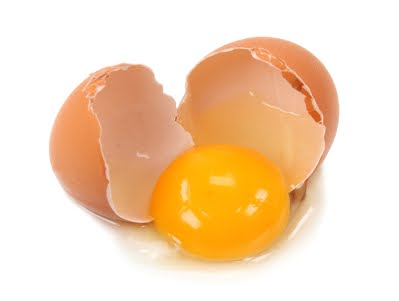 Velouté
Velouté- is a stock-based white sauce. It can be made from chicken, veal or fish stock. Enrichments such as egg yolks or cream are sometimes also added.
- Brown
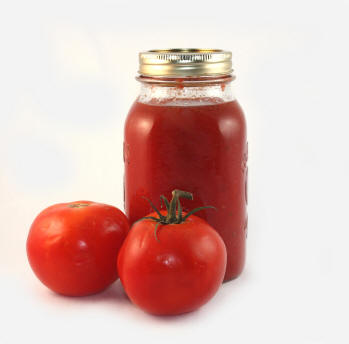
- is traditionally made of a rich meat stock, a mirepoix of browned vegetables (most often a mixture of diced onion, carrots and celery), a nicely browned roux, herbs and sometimes tomato paste.
- Tomato
- is traditionally made of ripe tomatoes, a mirepoix of browned vegetables (most often a mixture of diced onion, carrots and celery), cooked in a little olive oil, to which garlic, and seasonings are added. The sauce can be dressed up with mushrooms, sausage, olives, wine, and all manner of vegetables.
- Hollandaise
- is made with an emulsion of egg yolks and fat. It is made with butter, egg yolks and lemon juice, usually in a double boiler to prevent overheating, and served warm. It is generally used to embellish vegetables, fish and egg dishes, such as the classic Eggs Benedict.
Thickening agents:
- Roux
- Equal parts flour to fat (clarified butter is traditional). There are three different stages for rouxs including white, blond and brown. Full thickening power is not realized until sauce or soup is brought up to a simmer after the roux is incorporated. Constantly stir roux-thickened sauces while cooking to prevent lumps. If you must leave the sauce for a few seconds, set the pan off the heat during that time.
- Cornstarch
- Has twice the thickening power of flour. Most commonly added to a soup or sauce in a slurry form, using a 1:1 mixture of water to Corn Starch. To thicken a sauce or soup with the consistency of water to a traditional nape stage (coats the back of a spoon), you will need 2 oz of Corn Starch for every 1 qt of sauce or soup. Full thickening power will not be realized until your sauce begins to simmer. Corn Starch has tendency to give sauces a smooth and shinny appearance.
- Whitewash
- A mixture of water and flour is whisked together into a “slurry” before being incorporated into a sauce. The water helps to hydrate the starch
molecules in the flour, preventing the flour from clumping when it hits the hot sauce or soup. This is a poor technique andis only listed here for sake of completeness
Flavouring agents:
- Mirepoix
- a combination of chopped carrots, celery and onions used to add flavor and aroma to stocks, sauces, soups and other foods. The proportions (by weight) for making mirepoix are 50% onions, 25% carrots and 25% celery.
- Bouquet garni
- is a bundle of herbs usually tied together with string and mainly used to prepare sauces & soups. It is cooked with the other ingredients, but is removed prior to consumption. Most recipes include parsley, thyme and bay leaf and include basil, burnet, chervil, rosemary, peppercorns, savory and tarragon.
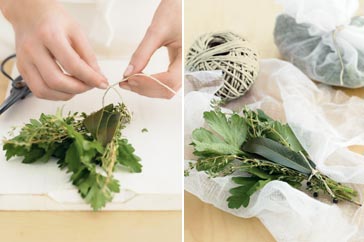
Soups in cuisine
Lesson Questions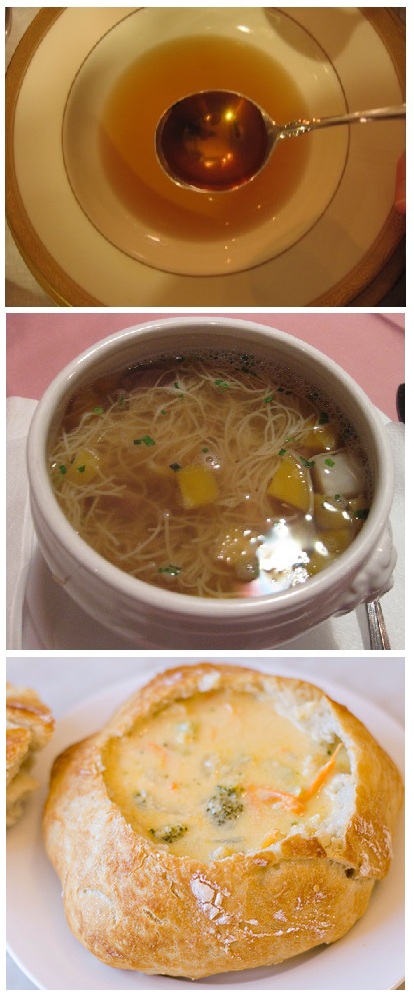
- What is the role of soups in cuisine?
- Identify types of soups, thickening agents and flavours.
Lesson
Our word soup comes from French soupe, which derived from Latin verb suppare, to soak, which indicated bread soaked in broth.The bread or toast served as an alternative to using a spoon and that evolved into croutons. Soup was a poor man’s dinner. Until recent times, the evening meal was the lighter of the two meals of the day; a soup or sop would be a typical evening dish. The name of the meal evolved to souper, than supper. It began to be fashionable to serve the liquid broth without the sop (bread), and in the early eighteenth century, soup became a first course
Types of soups:
- Clear soups
- a thin soup are made from a clear stock foundation. One way to distinguish them is that a consomme is always served plain (with an optional garnish), whereas broth can be made more substantive with the addition of a grain (corn, barley, rice) and vegetables. Plain broth is a thin soup, but it can be thickened with the addition of rice, potatoes, barley, vegetables or eggs. Examples with eggs include Chinese chicken egg drop soup, Greek avgolemono soup and Italian stracciatella soup.
- Thick soups
- classified depending upon the type of thickening agent used:
- purées are vegetable soups thickened with starch;
- bisques are made from puréed shellfish or vegetables thickened with cream;
- cream soups may be thickened with béchamel sauce;
- veloutés are thickened with eggs, butter, and cream.
- Other ingredients commonly used to thicken soups and broths include rice, lentils, flour, and grains; many popular soups also include carrots and potatoes.
Thickening agents:
- Roux
- Equal parts flour to fat (clarified butter is traditional). There are three different stages for rouxs including white, blond and brown. Full thickening power is not realized until sauce or soup is brought up to a simmer after the roux is incorporated. Constantly stir roux-thickened sauces while cooking to prevent lumps. If you must leave the sauce for a few seconds, set the pan off the heat during that time.
- Cornstarch
- Has twice the thickening power of flour. Most commonly added to a soup or sauce in a slurry form, using a 1:1 mixture of water to Corn Starch. To thicken a sauce or soup with the consistency of water to a traditional nape stage (coats the back of a spoon), you will need 2 oz of Corn Starch for every 1 qt of sauce or soup. Full thickening power will not be realized until your sauce begins to simmer. Corn Starch has tendency to give sauces a smooth and shinny appearance.
- Whitewash
- A mixture of water and flour is whisked together into a “slurry” before being incorporated into a sauce. The water helps to hydrate the starch molecules in the flour, preventing the flour from clumping when it hits the hot sauce or soup. This is a poor technique andis only listed here for sake of completeness
Flavouring agents:
- Mirepoix
- a combination of chopped carrots, celery and onions used to add flavor and aroma to stocks, sauces, soups and other foods. The proportions (by weight) for making mirepoix are 50% onions, 25% carrots and 25% celery.
- Bouquet garni
- is a bundle of herbs usually tied together with string and mainly used to prepare sauces & soups. It is cooked with the other ingredients, but is removed prior to consumption. Most recipes include parsley, thyme and bay leaf and include basil, burnet, chervil, rosemary, peppercorns, savory and tarragon.
Demonstrate Sauce and Soup preparation
In this lesson, your task is to prepare five dishes meeting the following conditions:
1. A savory sauce
2. A sweet sauce
3. A broth soup
4. A cream or blended soup
5. One innovative nutritionally enhanced soup based on a commercial product. (For instance, take a canned soup and make it healthier)
We are including a few recipes for you. Feel free to try them or use your own recipies.
Savory Sauces:
Sweet Sauces:

Broth soups:
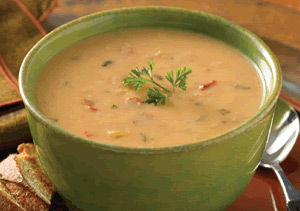
Cream or Blended soups: